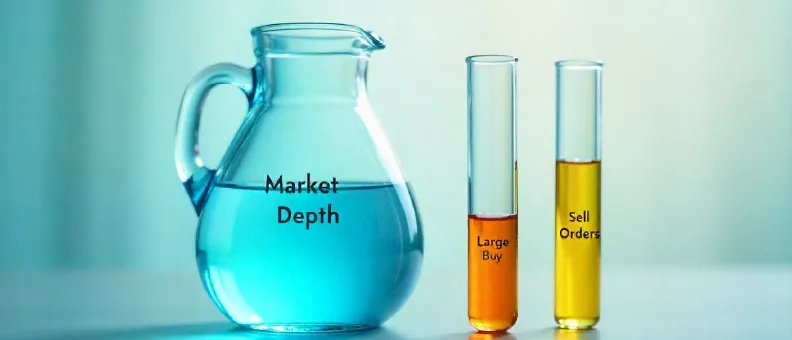Market Depth: Meaning, Working & Limitations


When you gain some experience and decide to dive deeper into the world of investments, you may come across newer terms and tools you have never heard of before. One such widely-used term is “market depth”. This term refers to the ability of the market to sustain large orders (buy or sell) without causing a major impact on the price of a security.
In this article, we will understand what market depth is, how it works, its examples and why it matters to investors. We will also discuss the tools used to view market depth and their limitations.
- Table of contents
- What is Market depth
- Working of Market depth
- Example of Market depth
- Why Market depth matters
- Tools to view Market depth
- Interpretation of Market depth
- Limitation of Market depth
- Building a long-term investment strategy
What is Market depth
Market depth means how efficiently a market can handle large buy or sell orders without causing a significant change in the asset's price. It shows how many shares of a particular stock can be bought or sold without significantly pushing its price up or down. Market depth is closely linked to a stock’s trading volume and liquidity. A higher depth generally means higher liquidity, making it easier to trade large quantities with minimal price movement.
For example, a stock with a high number of buy and sell orders across various price levels is considered to have a deep market. On the other hand, a stock with fewer orders might have shallow market depth, indicating lower liquidity and a higher chance of price volatility with large trades.
Working of Market depth
Market depth is shown through an electronic list of buy and sell orders, organised by price levels, which is maintained by stock exchanges. Most trading platforms display this list in real time so that traders can see it, while in some cases, access to this data may come at a cost––i.e., it may be behind a paywall.
This list, known as the limit order book, includes all the buy and sell orders that are waiting to be completed at specific prices. Each order shows how much of a stock someone wants to buy or sell and at what price. These limit orders are fixed and won’t change, even if the market moves. However, market depth doesn’t include possible future price changes, even if those changes are likely to bring in more orders.
Read Also: What are stocks?
Example of Market depth
Imagine a trader is looking at the buy and sell orders for the stock of a company called XYZ. Right now, XYZ’s stock is trading at Rs. 10. There are about 300 sell orders waiting and 100 of them are at Rs. 11, 50 at Rs. 12, 100 at Rs. 13, and 50 at Rs. 15. On the buy side, there are fewer orders––25 orders at Rs. 8 and another 25 at Rs. 7.50.
Looking at this data, a trader can infer that sellers are only willing to sell at significantly higher prices but there is limited buying interest below Rs. 10. This may suggest that unless new buyers enter the market, the price might stay stable or even drop due to weaker demand. However, if buyers start placing new orders closer to Rs. 11, the price could rise as the higher sell orders will start getting filled.
*Example for illustrative purposes only.
Analysing such information can help traders anticipate potential price movements and make informed buy/sell decisions.
Why Market depth matters
- Helps understand liquidity: A deeper market suggests higher liquidity, meaning traders may be able to enter and exit positions without much price impact.
- Assists with better pricing: Market depth helps understanding where most orders are placed which can potentially help traders optimise entry and exit points.
- Identifies support and resistance levels: Market depth assists in identifying support and resistance levels. Dense order clusters at specific prices can indicate potential turning points.
- Gauges market sentiment: Market depth shows market sentiment. Many buy orders above the current price may hint at a bullish sentiment (buyers are willing to pay more). Conversely, many sell orders at prices lower than the current price may indicate a bearish sentiment (sellers are keen to exit positions).
Tools to view Market depth
The most crucial tool for viewing is the depth of market (DOM) order book, which is available on all major trading platforms. This shows live buy (bid) and sell (ask) orders.
Order book heatmaps are graphical representations of the liquidity conditions of the order book, buy and sell orders across different price levels and over time.
The time and sales (tape reading) tool provides a real-time, chronological list of every trade executed in the market. It displays the price, volume, and time of each transaction.
Volume profile visualises volume distribution across prices, indicating support/resistance.
It must be noted that access to deep, real-time data might be a paid or subscription-based service on some platforms.
Interpretation of Market depth
- Market depth data can help traders predict where a security’s price might be headed by showing the number of buy and sell orders at various price levels. Traders use this data to understand the bid-ask spread and the volume of orders placed above or below certain price levels.
- Securities with strong market depth usually have high trading volumes and good liquidity, making it easier to place large orders without affecting the price too much. On the other hand, low market depth can cause large orders to move the price significantly.
- Market depth is displayed in an electronic order book, which updates in real-time and lists buy and sell orders organised by price.
- Real-time depth data potentially helps traders take advantage of short-term price movements, like during an IPO, when high demand may signal rising prices.
Limitation of Market depth
- Too much information: The constant stream of real-time data can overwhelm traders, especially beginners. This may lead to “analysis paralysis”, where traders hesitate to act due to too many signals. Learning to focus on key information and filtering out the noise is essential.
- Risk of manipulation: Some traders or institutions use tactics like “spoofing” which is placing large fake orders to mislead others. This can distort the actual market sentiment, so it’s important to spot such false signals and not rely blindly on market depth.
- Limited use in certain markets: In low-liquidity or over-the-counter (OTC) markets, such as some small cap stocks or commodities, market depth data may not show the full picture. Here, traders should combine market depth with other tools to get more reliable insights.
Building a long-term investment strategy
While market depth can be useful for identifying short-term trading opportunities, long-term investors may not need to rely heavily on it. Instead, they may prefer focusing on company fundamentals, sectoral performance, risk tolerance alignment, asset allocation, and diversification.
Read Also: What is Scalp trading?
Conclusion
Market depth is an invaluable tool that shows real-time buy and sell orders for a security at various price levels. It can help traders to assess liquidity, potentially predict short-term movements and enables them to make informed trading decisions.
FAQs:
What is Level 2 market data?
Level II data offers detailed insight into a stock’s price action beyond immediate bid-ask spreads, showing which traders are active and potentially helping predict short-term price direction based on buy and sell order patterns.
How is market depth calculated?
Market depth is calculated by aggregating the number of buy and sell orders at various price levels for a given security. These figures are compiled in real-time and shown via order books.
Is market depth useful for intraday traders?
Yes, intraday traders may find market depth helpful as it gives insights into short-term demand and supply, which may potentially support more informed trading decisions.
What are fake orders in market depth?
Fake orders are those placed with the intention of misleading other traders, usually by placing large orders and then cancelling them quickly.
Can market depth predict price movement?
Market depth can offer potential clues about potential price movements, especially in the short-term.
Mutual Fund investments are subject to market risks, read all scheme related documents carefully.
This document should not be treated as endorsement of the views/opinions or as investment advice. This document should not be construed as a research report or a recommendation to buy or sell any security. This document is for information purpose only and should not be construed as a promise on minimum returns or safeguard of capital. This document alone is not sufficient and should not be used for the development or implementation of an investment strategy. The recipient should note and understand that the information provided above may not contain all the material aspects relevant for making an investment decision. Investors are advised to consult their own investment advisor before making any investment decision in light of their risk appetite, investment goals and horizon. This information is subject to change without any prior notice.
The content herein has been prepared on the basis of publicly available information believed to be reliable. However, Bajaj Finserv Asset Management Ltd. does not guarantee the accuracy of such information, assure its completeness or warrant such information will not be changed. The tax information (if any) in this article is based on prevailing laws at the time of publishing the article and is subject to change. Please consult a tax professional or refer to the latest regulations for up-to-date information.